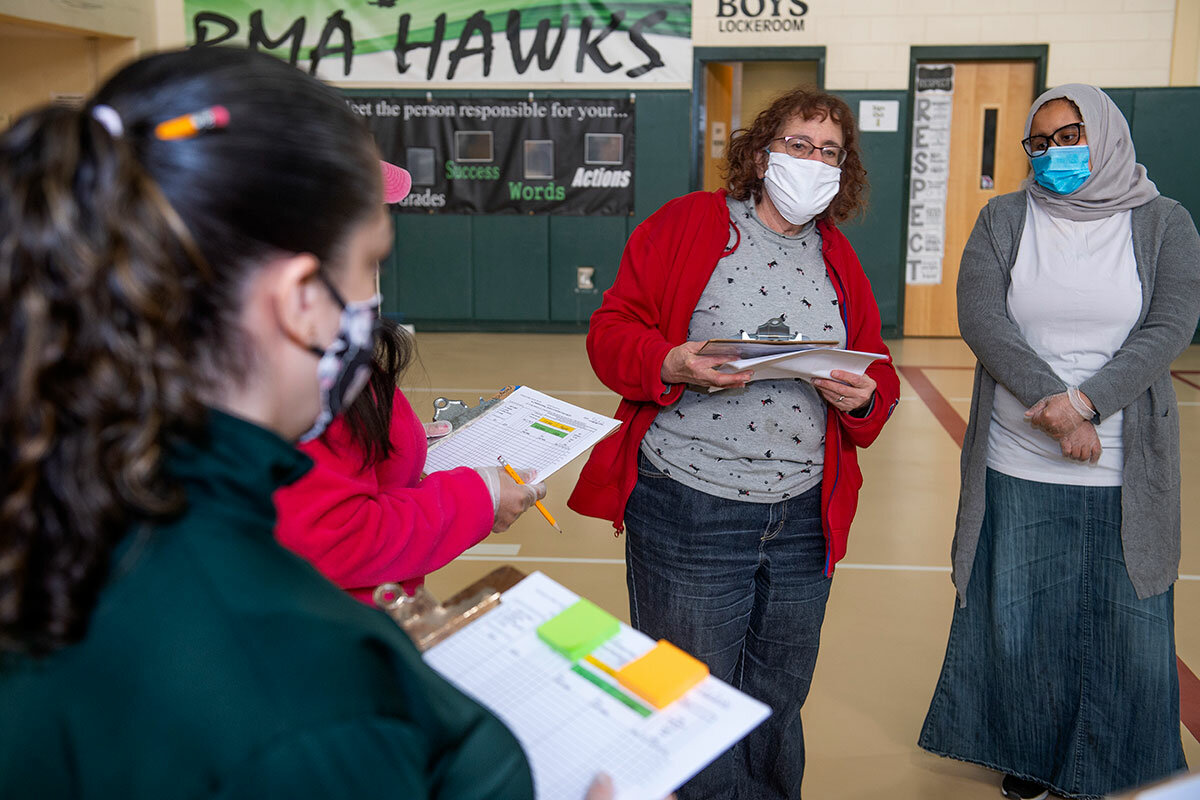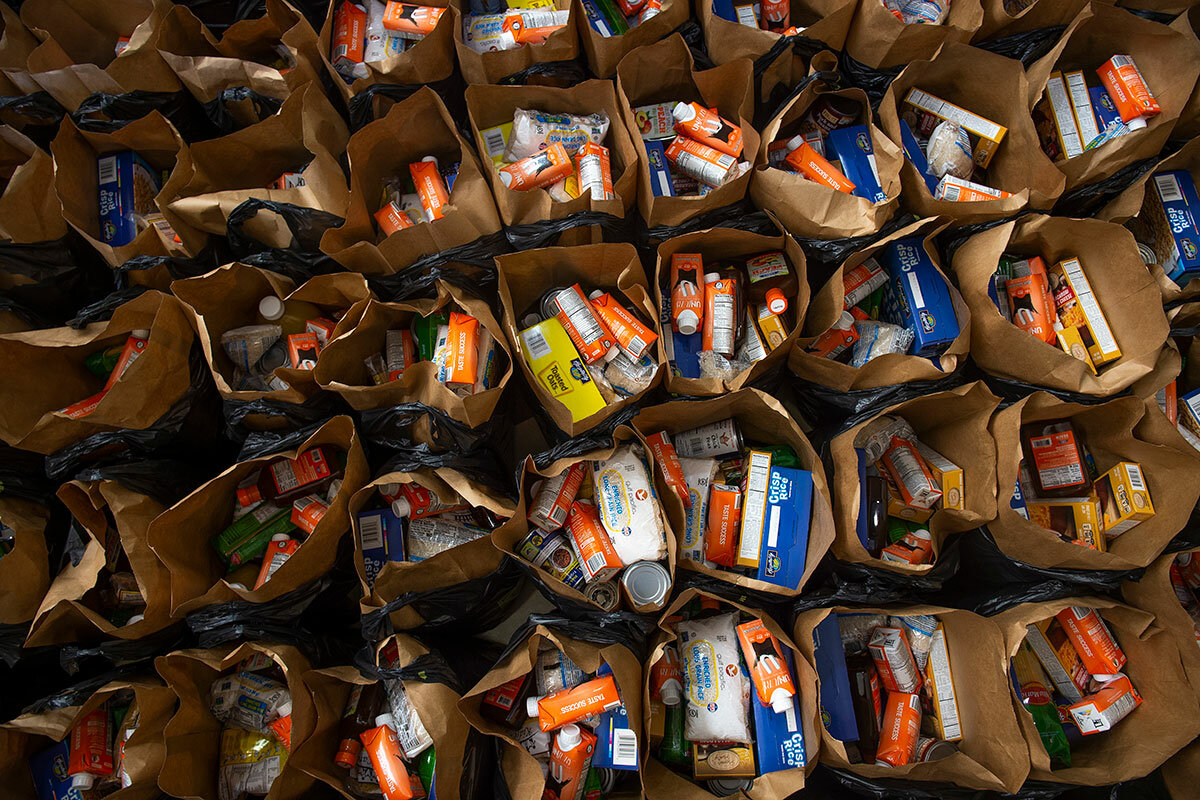Feeding America during COVID-19: How food pantries are meeting record demand
| Revere, Mass.
On a crisp May evening, Wendy Baur had earned a rest by the time dusk fell on a middle school gymnasium that was transformed into a supersized food pantry for the pandemic. Responding to a 630% increase in need since mid-March, she and her team of 55 volunteers had just handed out full grocery bags to about 375 families reeling from this gateway city’s economic collapse. It was time to go home.
But Ms. Baur, who’s directed the First Congregational Church of Revere food pantry in Massachusetts for 18 years, wasn’t relaxing as she leaned on a stack of canned soup cases. She was worrying. If even one volunteer tests positive for COVID-19, she said, the operation might grind to a halt as all contacts would have to quarantine. Just as concerning: the prospect of running out of food.
“Every week it’s a struggle to resupply, to get more food,” says Ms. Baur, who also runs a research lab at Tufts Medical Center. “All of the food pantries are competing for a time slot at the food bank warehouse. Some days I can’t even get a slot. ... I get online at midnight when you can pick your slot, but when I get on, they’re all taken. They’re gone within one second.”
Why We Wrote This
Amid coronavirus closures, America’s food pantries are facing a pandemic paradox: dwindling supplies and skyrocketing need. With tenacity and heart, they’re stepping up to the challenge.
Editor’s note: As a public service, all our coronavirus coverage is free. No paywall.
Such anxieties aren’t unique to this pantry in Revere, a city of 53,000. America’s network of 40,000 food pantries, which give away food as part of a patchwork emergency system, is facing a perfect storm of challenges spawned by the coronavirus outbreak. Need, costs, and pantry closures have spiked simultaneously. Volunteers including Ms. Baur now scramble to prevent what happened in Revere in mid-March, when the pantry ran out of food for the first time in its 36-year history and had to turn people away.
Unprecedented challenges
Nationwide, as many as 10,800 pantries and meal programs have shut down since the pandemic began, according to figures from Feeding America, a network of 200 food banks serving pantries and meal programs. One reason: not enough volunteers. Many were run by seniors who are now high risk and stay home to avoid the virus. Others have had to close after someone tested positive for COVID-19.
Meanwhile, need has skyrocketed. Pantries and meal programs gave out about 32% more food in April than a year earlier, according to Feeding America, as the number of food-insecure Americans jumped from 37 million in 2018 to as many as 54 million today.
“The emergency food system is dependent on charitable organizations, on volunteers, on quick adaptability – and that’s been challenged during this time,” says Alicia Powers, managing director of the Hunger Solutions Institute at Auburn University in Alabama. “These systems have been tried in ways that we never imagined.”
What’s more, staples are getting more expensive – if pantries can find them at all. The Greater Boston Food Bank used to be able to offer pantries more options at no cost, but lists of available free items are getting shorter and shorter, according to Vice President of Distribution Services Jonathan Tetrault.
“At this point, the options to choose from are diminishing because of the supply chain challenges,” Mr. Tetrault says. For no cost, pantries were able to get pasta, white rice, brown rice, black beans, pinto beans, and kidney beans. “Now your option this week is white rice only and one type of bean.”
Grocery chains have been selling out of items like canned vegetables, leaving them with less to donate to food banks, according to Feeding America spokesperson Zuani Villarreal. That leaves pantry organizers having to pay at food banks or buy from stores at a time when everything from eggs to meat is costing more due to heightened demand and scant supply.
Since the pandemic started, “I have to buy more at the store, and I have to pay more for it,” says Linda Crocker, a volunteer pantry coordinator at The Memorial Church of the Good Shepherd in Parkersburg, West Virginia. In normal times, she spends about $1,000 a month to stock her pantry to feed about 45 families. Now with less at food banks, higher prices in stores, and more families seeking help, her spending has jumped by about 30%.
Meeting growing needs
New challenges facing pantries are on display every Wednesday night here at Rumney Marsh Academy, which the city of Revere converted to an emergency food hub soon after schools closed for the pandemic. Prior to March, the pantry (Revere’s only one) had been located at the church, where a human chain would pass bundles up from the basement through a hole in the floor. But that was when 8,000 pounds of food and supplies a month was enough. Now the pantry is going through upward of 40,000 pounds a month. Moving temporarily to the larger school facility on a state highway was essential.
Before distribution begins at 7 p.m., more than 100 cars form two lines that wind around the building. Dozens of pedestrians line up beside them on a sidewalk. Everyone is wearing masks. Guidelines to stay six feet apart are loosely followed.
On this night in mid-May, 72% of pantry visitors are Hispanic, up from 33% in mid-March, according to Ms. Baur. Speaking in Spanish, one guest after another tells a similar story of layoffs. Jose Santiago lost his janitorial job at a food processing center. Leticia Restrepo is no longer cooking at a restaurant. Jorge Tovon can’t work at the airport hotel where he’s tended a bar for 14 years. All have stretched their personal accounts for weeks, then started coming to the pantry in May because it was getting tougher to provide for family members who depend on them.
“I was embarrassed to come here, but now we need it,” says Angela, who asked that her last name not be used. She thought her furlough from office work would be brief, but two months later she’s still unemployed.
“People see the need”
Inside, volunteers stuffing bags in assembly-line fashion say it’s just their second or third week at the pantry. Among those answering the call for helpers is David Eatough, a Revere High School biology teacher. He’s seen up close what it means for Revere to have one of the higher infection rates in Massachusetts. Two students at the high school lost a parent to the virus, he said, and a former student has died as well.
Volunteering comes with health risks. But Mr. Eatough feels the risks are manageable – and worth it. Like other volunteers, he wears gloves, keeps his mask on, and fills bags to feel helpful in a situation that’s left many feeling helpless.
“I’m helping [the community] and at the same time helping myself by keeping busy,” Mr. Eatough says. Volunteering at the pantry “alleviates some of that sense of helplessness that I think all of us feel to some degree.”
Behind the scenes, Ms. Baur aims to keep one wall of the gymnasium stacked 6 feet high from end to end with chickpeas, canned tomatoes, pasta, and other goods. She takes pride in stocking protein such as ground turkey, cheese, and frozen eggs, which are stored separately in a school kitchen.
But the logistics can be daunting. On her June to-do list: lining up a reliable volunteer trucker, if needed, to transport supplies.
In the meantime, she stretches her budget by stocking up on whatever she can get free from the food bank, such as cases of USDA peanut butter. For a 5,000-pound midweek delivery, she paid for only three items: 480 jars of jelly – “it goes with the peanut butter” – 2,000 shopping bags, and a case of gloves for volunteers. Total: $601.
Now as she prepares to leave for the night, her phone rings. It’s her pastor with good news: The pantry got a $10,000 donation from a Boston health care organization. She can use it. The pantry spent about $10,000 on food in April, a 10-fold increase from a year earlier.
“Sometimes it can be 6,000 pounds and I’m paying $1,000 because none of the stuff I want happens to be free,” Ms. Baur says. “On the plus side, there have been a lot of donations. People see the need.”
Editor’s note: As a public service, all our coronavirus coverage is free. No paywall.








